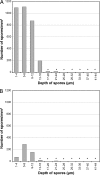Rapid filtration separation-based sample preparation method for Bacillus spores in powdery and environmental matrices
- PMID: 22210204
- PMCID: PMC3294465
- DOI: 10.1128/AEM.06696-11
Rapid filtration separation-based sample preparation method for Bacillus spores in powdery and environmental matrices
Abstract
Authorities frequently need to analyze suspicious powders and other samples for biothreat agents in order to assess environmental safety. Numerous nucleic acid detection technologies have been developed to detect and identify biowarfare agents in a timely fashion. The extraction of microbial nucleic acids from a wide variety of powdery and environmental samples to obtain a quality level adequate for these technologies still remains a technical challenge. We aimed to develop a rapid and versatile method of separating bacteria from these samples and then extracting their microbial DNA. Bacillus atrophaeus subsp. globigii was used as a simulant of Bacillus anthracis. We studied the effects of a broad variety of powdery and environmental samples on PCR detection and the steps required to alleviate their interference. With a benchmark DNA extraction procedure, 17 of the 23 samples investigated interfered with bacterial lysis and/or PCR-based detection. Therefore, we developed the dual-filter method for applied recovery of microbial particles from environmental and powdery samples (DARE). The DARE procedure allows the separation of bacteria from contaminating matrices that interfere with PCR detection. This procedure required only 2 min, while the DNA extraction process lasted 7 min, for a total of <10 min. This sample preparation procedure allowed the recovery of cleaned bacterial spores and relieved detection interference caused by a wide variety of samples. Our procedure was easily completed in a laboratory facility and is amenable to field application and automation.
Figures


Similar articles
-
Internal control for nucleic acid testing based on the use of purified Bacillus atrophaeus subsp. globigii spores.J Clin Microbiol. 2009 Mar;47(3):751-7. doi: 10.1128/JCM.01746-08. Epub 2009 Jan 14. J Clin Microbiol. 2009. PMID: 19144808 Free PMC article.
-
A simple method for the rapid removal of Bacillus anthracis spores from DNA preparations.J Microbiol Methods. 2009 Feb;76(2):212-4. doi: 10.1016/j.mimet.2008.10.009. Epub 2008 Oct 28. J Microbiol Methods. 2009. PMID: 18996156
-
Recovery of bacillus spore contaminants from rough surfaces: a challenge to space mission cleanliness control.Appl Environ Microbiol. 2011 Mar;77(5):1628-37. doi: 10.1128/AEM.02037-10. Epub 2011 Jan 7. Appl Environ Microbiol. 2011. PMID: 21216908 Free PMC article.
-
Identification of bacterial spores using statistical analysis of Fourier transform infrared photoacoustic spectroscopy data.Appl Spectrosc. 2003 Aug;57(8):893-9. doi: 10.1366/000370203322258832. Appl Spectrosc. 2003. PMID: 14661830 Review.
-
Laboratory studies on surface sampling of Bacillus anthracis contamination: summary, gaps and recommendations.J Appl Microbiol. 2012 Dec;113(6):1287-304. doi: 10.1111/j.1365-2672.2012.05381.x. Epub 2012 Sep 17. J Appl Microbiol. 2012. PMID: 22747878 Review.
Cited by
-
Rapid and efficient filtration-based procedure for separation and safe analysis of CBRN mixed samples.PLoS One. 2014 Feb 5;9(2):e88055. doi: 10.1371/journal.pone.0088055. eCollection 2014. PLoS One. 2014. PMID: 24505375 Free PMC article.
-
Evaluation of Gamma-Radiation Inactivation of a Bioterrorism Agent, Bacillus anthracis Spores, on Different Materials.Indian J Microbiol. 2018 Mar;58(1):76-80. doi: 10.1007/s12088-017-0691-z. Epub 2017 Nov 9. Indian J Microbiol. 2018. PMID: 29434400 Free PMC article.
References
-
- Carrera M, Zandomeni RO, Fitzgibbon J, Sagripanti JL. 2007. Difference between the spore sizes of Bacillus anthracis and other Bacillus species. J. Appl. Microbiol. 102:303–312 - PubMed
-
- Dauphin LA, Moser BD, Bowen MD. 2009. Evaluation of five commercial nucleic acid extraction kits for their ability to inactivate Bacillus anthracis spores and comparison of DNA yields from spores and spiked environmental samples. J. Microbiol. Methods 76:30–37 - PubMed
-
- Geissler M, et al. 2011. Extraction of nucleic acids from bacterial spores using bead-based mechanical lysis on a plastic chip. Eng. Life Sci. 11:174–181
-
- Gilchrist MJR, McKinney WP, Miller JM, Weissfield AS. 2000. Cumitech 33, Laboratory safety, management, and diagnosis of biological agents associated with bioterrorism. Coordinating ed, Snyder JW. ASM Press, Washington, DC
-
- Kellogg DE, et al. 1994. TaqStart antibody: “hot start” PCR facilitated by a neutralizing monoclonal antibody directed against Taq DNA polymerase. Biotechniques 16:1134–1137 - PubMed
Publication types
MeSH terms
Substances
Grants and funding
LinkOut - more resources
Full Text Sources

